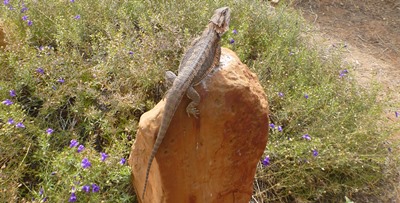Watch out for lizards on roads in the morning or early evening, and after dark on hot days.
A work colleague at Low Ecological Services was driving to work one morning and stopped to remove Bearded Dragons from on the road, not just once, but three times. The eventful trip caused us to wonder about, not only their ecological and physiological needs (e.g. warm, sunny spots for body heating), but also of their habitat requirements. Our Land for Wildlife and Garden for Wildlife members might be happy to note that there are many things that can work in urban and peri-urban native gardens that can benefit this particular native species and attract them to use your garden as habitat.
As their name implies…
The Bearded Dragon derives its common name from the ‘guttural pouch’, a pouch-like projection under the neck and chin areas, and which turns a darker colour than the rest of the body, male beards typically being darker than females. Bearded Dragons have specialised scales along both sides of the throat, neck, and head that form many narrow spines running down the side of the body to the tail. These scales/spines are not as sharp as they are rubbery, and a useful evolutionary characteristic with which to convince potential predators that they would make a painful meal. When feeling threatened, a Bearded Dragon will flatten its body against the ground, puff out its spiny throat and open its jaws to make itself appear larger. Bearded Dragons are not known to attack humans.
Native to the Alice Springs area is the Central Bearded Dragon (Pogona vitticeps). Being skilled climbers, the Dragons spend as much time in elevated positions such as trees and fence posts, as they do on the ground. Morning and early evenings are spent sunning themselves in warm, exposed areas, such as rocks or branches. During the hotter times of the day, they will use shady areas or underground burrows as refuges from the heat. They can also change their colour slightly (lighter/darker) to moderate their body temperature, though not as dramatically as a Gecko!
(Anti-)Social habits.
Although not social animals, they will sometimes gather for a group ‘bask-off’ in a sunny area. Researchers have discovered that a hierarchy exists amongst Dragon basking groups. The highest-ranking animals will take the best basking spots, usually the highest or sunniest, while others arrange themselves lower down. If a low-ranking animal tries to challenge one of the dominant Dragons, the dominant Dragon will demonstrate its superiority by bobbing its head and inflating its beard, at which point the challenger may signal submission by waving one of its front legs in a circle. However, if the low-ranking Dragon doesn’t submit, it will return the head bob and a standoff or fight can ensue. Females also use a wave and a slow head bob to indicate when they are ready to mate.
Incorporating Bearded Dragon habitat into your garden.
If you live near woodlands or dry eucalypt forests, you may see Bearded Dragons coming to investigate your garden, looking for food or a good spot to sun themselves. Considerations for Dragon habitat in your garden should be given to having an area that is restricted to pets and has basking areas that are exposed to the morning sun, such as a large rock, garden pavers or available tree branches. Mulch your garden beds so that lizards and other insects will be available as a Bearded Dragon food source. Bearded Dragons will eat insects, ants, beetles, cockroaches, spiders, and the occasional small rodent or lizard. They are also known to eat some plant matter such as fruit or leaves. Provide water in a shallow dish on the ground for them, and always keep the water fresh.

Categories:
Native Fauna, Reptiles, Uncategorized, Weather